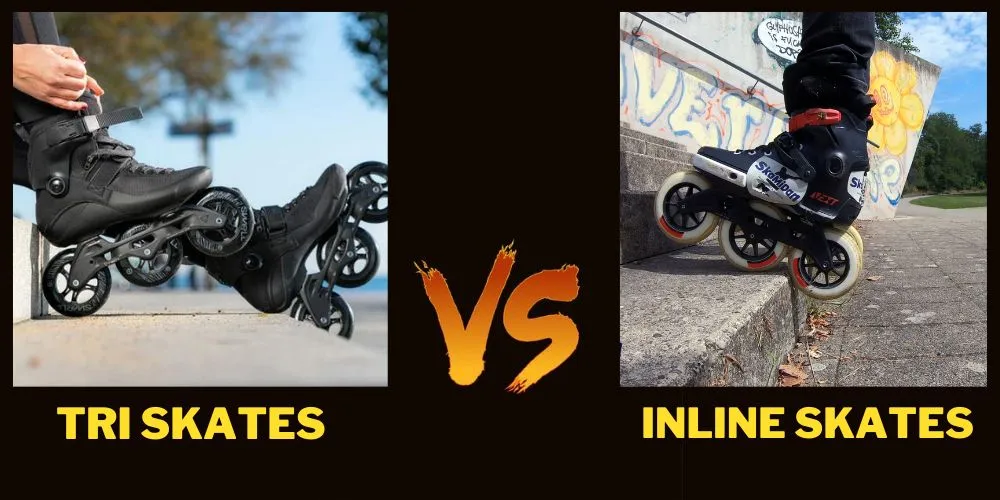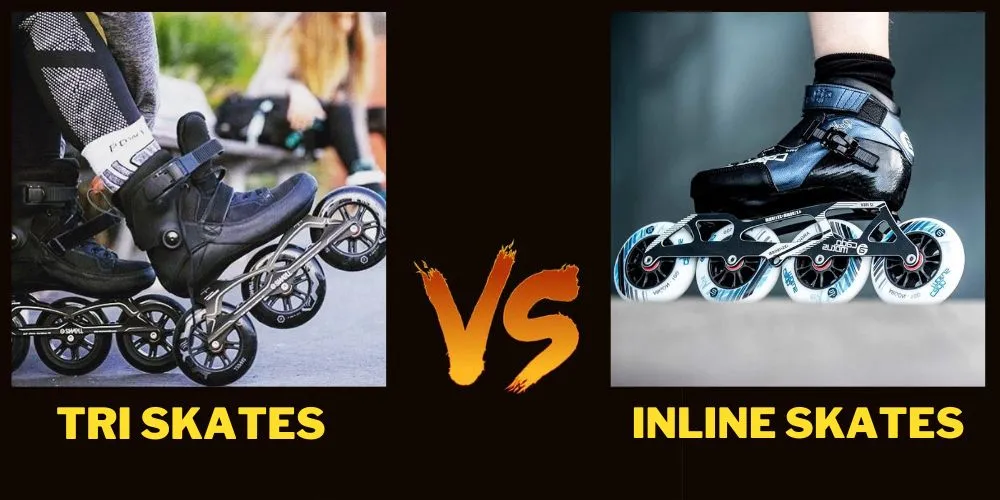Skating has seen various evolutions over the years, with each type catering to different preferences, needs, and skill levels. Two popular variations in the realm of skating are Tri Skates and Inline Skates. Both have their distinct features, advantages, and enthusiasts.
Understanding the nuances of tri skates vs inline skates can help enthusiasts make informed decisions. This article dives deep into comparing these two types of skates to aid in your choice.

What are Tri Skates?
Tri Skates, as their name hints, come with three wheels. These skates are designed to offer a blend of speed, agility, and stability. The key characteristic setting them apart is the three large wheel configuration.
This design enables smoother rides over various surfaces and better maneuverability. Tri Skates are often preferred for activities that require quick turns and adaptability.
What are Inline Skates?
Inline Skates, the more traditional variant, typically feature a row of four to five wheels. They have been popular since their inception for offering a balanced skating experience.
Ranging from recreational to aggressive styles, inline skates have evolved to fit various skating activities. The history of Inline Skates is rich, tracing back to the early 1980s, marking them as a staple in roller sports.
Tri Skates vs Inline Skates: Comparing
When comparing these two, several factors come into play, including wheel size, comfort, maneuverability, speed, and the learning curve.

Wheel Size and Configuration
The larger wheels of Tri Skates allow for a smoother ride over bumps and uneven surfaces. This can be particularly appealing for city skaters. In contrast, Inline Skates, with their four or five smaller wheels, offer stability and precision.
Boot Design and Comfort
Comfort is crucial in skating. Tri Skates often come with softer, more adaptable boots due to the need to accommodate larger wheel configurations. Inline Skates, however, offer a range of designs from hard to soft boots, each serving different skating styles.
Maneuverability
Turning and quick maneuvers are where Tri Skates excel due to their unique wheel arrangement. Inline Skates, though stable, might not offer the same level of agility in tight turns but excel in steady, linear motion.
Speed and Efficiency
For those looking for speed, the larger wheels of Tri Skates can be beneficial. However, Inline Skates are no slouch in this department, especially models designed for racing that leverage their wheel configuration for maximum speed.
Learning Curve
Beginners might find Tri Skates more forgiving due to their stability and ease of getting up to speed. Inline Skates, with their traditional layout, might present a steeper learning curve but offer a wider range of skills development over time.
Pros and Cons of Tri Skates
Pros
✅Better agility and easier to turn
✅Smooth rides over rough surfaces
✅Generally quicker to learn for beginners
Cons
❌Can be more expensive due to innovative design
❌Less variety compared to Inline Skates
Pros and Cons of Inline Skates
Pros
✅Versatility across different styles of skating
✅More options available in the market
✅Preferred for specific sports like aggressive or speed skating
Cons
❌Might be harder to learn for absolute beginners
❌Smaller wheels may not handle rough surfaces as well
Choosing Between Tri Skates and Inline Skates
Making the choice between Tri Skates and Inline Skates largely depends on personal preferences and goals.
Consider the environment you’ll be skating in, your expectations regarding speed and agility, and, importantly, comfort and fit. Weight, foot size, and height can indeed influence your decision as skates perform differently based on these factors.

Maintenance and Care for Tri Skates and Inline Skates
Maintaining and caring for Tri Skates and Inline Skates is crucial for prolonging their life and ensuring the best performance. Here are some key points to consider:
- Regular Inspection: Frequently inspect skates for any signs of wear or damage, focusing on the wheels, bearings, and the boot.
- Cleaning Bearings: Remove bearings periodically and clean them with a suitable solvent. Dry thoroughly before lubricating to ensure smooth rotation.
- Wheel Rotation and Replacement: Rotate wheels to even out wear and replace them when they show significant wear or damage.
- Boot Care: Clean the boot according to the material it’s made of. Use mild soap for soft boots and consider specialty cleaners for hard shells.
- Storage: Store skates in a dry, cool place away from direct sunlight to prevent damage from heat and moisture.
- Tightening Loose Parts: Regularly check and tighten any screws or bolts that may have loosened, including wheel axles and frame bolts.
By following these maintenance routines, you can enhance the skating experience, improve safety, and extend the lifespan of your Tri Skates or Inline Skates. Always refer to the manufacturer’s guidelines for specific maintenance advice related to your skates.
You may also find useful: Rollerblades vs Roller Skates | Inline Skates vs Quad Skates
Frequently Asked Questions (FAQs)
Are Tri Skates better for beginners than Inline Skates?
Yes, due to their stability and ease of handling, beginners may find Tri Skates more approachable.
How do I transition from Inline Skates to Tri Skates?
Focus on getting comfortable with the balance and maneuverability differences. Practice in safe, open areas to adjust to the feel of Tri Skates.
Can Tri Skates go as fast as Inline Skates?
Yes, Tri Skates can reach comparable speeds, especially models with larger wheels designed for speed.
What are the best brands for Tri Skates and Inline Skates?
Several brands are well-regarded in both categories. Research and personal preference play a significant role in choosing the best brand for you.
How often should I maintain my skates?
Regular maintenance after every few uses is recommended, though this can vary based on how frequently the skates are used and in what conditions.
Conclusion
Whether you lean towards the agility and modern design of Tri Skates or prefer the traditional, versatile Inline Skates, both offer exciting opportunities for enjoyment and exercise.
By considering the key differences and how they align with your skating ambitions, you can make a choice that best suits your lifestyle.

Matthew James is a passionate skater who wanted to create a platform to share his love for skating with others. With a vision to create a vibrant community of skaters, he aims to provide a space where skaters of all levels can connect, learn, and grow together.
